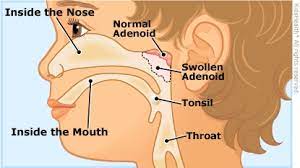Symptoms
Breathing through the mouth, especially in children, which also leads to a condition called malocclusion in which the teeth do not align properly when the jaw is closed.
Noisy breathing in daytime and snoring during the night.
The voice takes on a nasal quality.
When tonsils and adenoids become enlarged, they can obstruct the airways, potentially causing disrupted sleep and snoring. This, in turn, may result in more severe conditions like sleep pauses, also known as sleep apnea.
The child may also get other symptoms such as:
1.Restless sleep with frequent waking up
2.Mood swings
3.Bedwetting
4.Nightmares
5.Abnormal sleepiness
6.Cardiac problems.
Chronic enlargement and infection of the adenoids can also cause sinusitis (infection in sinus cavities) and/or blockage of nasal drainage that, in turn, can cause chronic ear infections arising due to inadequate ventilation of Eustachian tube (ear canal).
